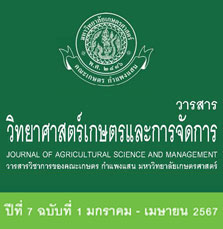Effects of Cucumber Seed Pelleting with Captan and Metalexyl on Seed Quality and Damping-Off Control in Laboratory Condition
Keywords:
fungicide; damping-off; seed pelleting; seed enhancementAbstract
Cucumber seeds often have inconsistent emergence and low vigor, and uneven growth after emergence, making it easy to be infested by Pythium spp., which is the cause of ‘damping-off’. However, this problem can be solved by using seed pelleting technology to pellet seeds with anti-fungal chemicals to enhance the efficiency of seed utilization. There was 2 experimental sets and the results were as follows: It was found that in the first experiment, seeds pelleted with 0.3, 0.5 g a.i. of metalaxyl and 0.1 g a.i. of captan had a high germination rate both before and after accelerated aging but did not different from non-pelleted seeds. The seeds pelleted with 0.5 g a.i. of metalaxyl showed higher shoot length than unpelleted seeds. After aging, it was found that the seeds pelleted with 0.3 g a.i. metalaxyl resulted in higher shoot length than other methods. Therefore, the seeds pelleted with 0.3 and 0.5 g a.i. of metalaxyl had the best effect on cucumber seed quality. Both formulas were used for the disease prevention test in the second experimental set and test results showed that seeds pelleted with metalaxyl at the concentration of 0.5 g a.i. had a fungal infection rate of 26%, which was lower than all other methods. As a result, seeds pelleted with metalaxyl at the concentration level of 0.5 g a.i. is the most recommended formula to pellet cucumber seeds for protection against Pythium spp. both during the pre-emergence and post-emergence periods
References
จักรพงษ์ กางโสภา และเพชรรัตน์ จี้เพชร. 2564. ผลของการเคลือบเมล็ดด้วย Metalaxyl, Captan และ Mancozeb หลังผ่านการทำไพรม์มิ่งต่อความงอกและการเจริญเติบโตของต้นกล้าข้าวโพดเลี้ยงสัตว์. วารสารวิทยาศาสตร์และเทคโนโลยี 29(3): 441-453.
จักรพงษ์ กางโสภา, อนันต์ วงเจริญ และบุญมี ศิริ. 2558. การพอกเมล็ดพันธุ์ร่วมกับสารป้องกันเชื้อราเพื่อยับยั้งเชื้อรา Pythium spp. ในระยะต้นกล้าของยาสูบ. แก่นเกษตร 43(4): 717-728.
ชณิตรา โพธิคเวษฐ์, ทรงศิลป์ พจน์ชนะชัย, อภิรดี อุทัยรัตนกิจ และภาณุมาศ ฤทธิไชย. 2553. ผลของการทำ priming ต่อคุณภาพของเมล็ดพันธุ์แตงกวา. วารสารวิทยาศาสตร์เกษตร 41(3): 405-408.
ธรรมศักดิ์ สมมาตย์. 2543. สารเคมีป้องกันกำจัดโรคพืช. ภาควิชาโรคพืช คณะเกษตรศาสตร์ มหาวิทยาลัยเกษตรศาสตร์, กรุงเทพมหานคร. 371 หน้า.
ธิดารัตน์ แก้วคำ และบุญมี ศิริ. 2553. ผลของการเคลือบเมล็ดด้วยสารป้องกันโรคและแมลงต่อคุณภาพเมล็ดพันธุ์แตงกวาลูกผสม. วารสารวิทยาศาสตร์เกษตร 46(1)พิเศษ: 480-483.
นิละมัย แสนสุภา, จักรพงษ์ กางโสภา, ประนอม ยังคำมั่น และฉัตรสุดา เผือกใจแผ้ว. 2565. ผลของการเคลือบเมล็ดร่วมกับ Streptomyces sp. CU-02 ต่อคุณภาพและการควบคุมโรคเน่าคอดินในผักกาดขาวปลี. วารสารวิทยาศาสตร์และเทคโนโลยี มรย. 7(1): 57-65.
บุญมี ศิริ. 2558. การปรับปรุงสภาพและยกระดับคุณภาพเมล็ดพันธุ์. พิมพ์ครั้งที่ 1. คลังนานาวิทยา, ขอนแก่น.
พัชรา คำพันธ์ และบุญมี ศิริ. 2564. การเปลี่ยนแปลงคุณภาพของเมล็ดพันธุ์แตงกวาลูกผสมหลังเคลือบร่วมกับสารควบคุม การเจริญเติบโตของพืช. วารสารแก่นเกษตร 49(1): 105-118.
พิสุทธิ์ เอกอำนวย. 2550. โรคและแมลงของพืชเศรษฐกิจที่สำคัญ. สายธุรกิจโรงพิมพ์. พิมพ์ครั้งที่ 1. อมรินทร์พริ้นติ้ง แอนด์ พับลิชชิ่ง, กรุงเทพมหานคร.
วนิดา ชื่นชัน, สุกันยา รักษาสระน้อย, สมศักดิ์ อยู่บริบูรณ์ และวรรณกร กิจจะ. 2562. การยับยั้งเชื้อรา Phytophthora parasitica ด้วยเชื้อราปฏิปักษ์ที่แยกได้จากดินในเขตพื้นที่ตำบลกุยบุรี จังหวัดประจวบคีรีขันธ์. วารสารวิทยาศาสตร์ลาดกระบัง 28(1): 53-64.
ศศิธร การะบุญ. 2551. ผลของความหนาของการพอกเมล็ดต่อคุณภาพเมล็ดพันธุ์. วิทยานิพนธ์ปริญญาวิทยาศาสตรมหาบัณฑิต สาขาวิชาวิทยาการหลังการเก็บเกี่ยว บัณฑิตวิทยาลัย มหาวิทยาลัยเชียงใหม่, เชียงใหม่.
สำนักควบคุมพืชและวัสดุการเกษตร. 2564. การส่งออกเมล็ดพันธุ์ควบคุมเพื่อการค้า ประจำปี พ.ศ. 2564. (ระบบออนไลน์). แหล่งข้อมูล: shorturl.at/dlMPZ. (3 มกราคม 2566).
สืบศักดิ์ สนธิรัตน์. 2540. การจัดการโรคพืช. ภาควิชาโรคพืช คณะเกษตร มหาวิทยาลัยเกษตรศาสตร์, กรุงเทพมหานคร. 141 หน้า.
Abbasi, P.A. and G. Lazarovits. 2006. Seed treatment with phosphonate (AG3) suppresses pythium damping-off of cucumber seedlings. Plant Disease 90(4): 459-464.
Bisognin, D. A. 2002. Origin and evolution of cultivated cucurbits. Ciência Rural 32: 715–723.
Bruce, A.F., P.F. Francis, Reay-Jones and T.G. Dewitt. 2008. Tobacco pest management. Pee Dee Research and Education Center 2: Issue 1.
Halmer, P. 2008. Seed technology and seeds enhancement. Acta Horticulturae 771: 17-26.
Hill, H.J. 1994. Seed pelleting-history and modern fundamentals. HortScience 29: 1408.
Iersel, V.M.W. and B. Bugbee. 1996. Phytotoxic effects of fungicides on bedding plants. Journal of the American Society for Horticultural Science 121: 1095-1102.
ISTA. 2018. International Rules for Seed Testing, Edition 2018. International Seed Testing Association, Bassersdorf, 19(8): 5-24.
Jeephet, J., C. Atnaseo, S. Hermhuk and J. Kangsopa. 2022. Effect of seed pelleting with different matrices on physical characteristics and seed quality of lettuce (Lactuca sativa). International Journal of Agricultural Technology 18(5): 2009-2020.
Kangsopa, J., R.K. Hynes and B. Siri. 2018. Lettuce seeds pelleting: A new bilayer matrix for lettuce (Lactuca sativa) seeds. Seed Science and Technology 46(3): 521-531.
Laemmlen, F. 2001. Damping-off diseases. University of California, ANR Publication 8041: 1-4.
Lu, P., D.R. Aimonino, G. Gilardi, M. L. Gullino and A. Garibaldi. 2010. Efficacy of different steam distribution systems against five soilborne pathogens under controlled laboratory conditions. Phytoparasitica 38(2): 175-189.






